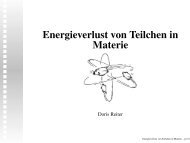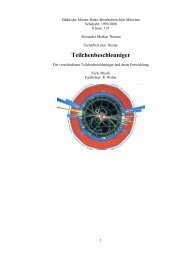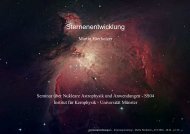The FEE Server Control Engine of the ALICE-TRD - Westfälische ...
The FEE Server Control Engine of the ALICE-TRD - Westfälische ...
The FEE Server Control Engine of the ALICE-TRD - Westfälische ...
You also want an ePaper? Increase the reach of your titles
YUMPU automatically turns print PDFs into web optimized ePapers that Google loves.
2 <strong>The</strong>oretical background<br />
Cold dense medium absorbs some <strong>of</strong> <strong>the</strong> created J/ψ. This effect is called normal suppression.<br />
But even if one takes this normal suppression into account, an additional suppression<br />
was seen by <strong>the</strong> NA50 collaboration (see figure 2.3). This additional suppression<br />
is likely caused by <strong>the</strong> presence <strong>of</strong> a QGP [NA500].<br />
For LHC energies <strong>the</strong> expectation is different. At <strong>the</strong>se collision energies a large number<br />
<strong>of</strong> charm and anti-charm quarks will be created. At hadronization <strong>the</strong>re is a certain<br />
chance that charm and anti-charm quarks will be close toge<strong>the</strong>r just for statistical reasons<br />
and form a J/ψ. <strong>The</strong>refore an enhancement ra<strong>the</strong>r than a suppression is expected for <strong>the</strong><br />
LHC data [BMS07].<br />
2.3.2 Jet-Quenching<br />
During <strong>the</strong> collision <strong>of</strong> nuclei in an accelerator, hard parton-parton collisions take place.<br />
Depending on <strong>the</strong> collision parameters <strong>the</strong> two partons can get large transverse momenta.<br />
Without <strong>the</strong> presence <strong>of</strong> a QGP <strong>the</strong> scattered partons fragment directly into<br />
hadrons which are moving in <strong>the</strong> direction <strong>of</strong> <strong>the</strong> primordial parton. This is called a<br />
jet. Since both scattered partons form a jet one sees two jets in an ϕangle <strong>of</strong> 180 °.<br />
In a QGP <strong>the</strong> situation is different. <strong>The</strong> parton scattering takes place in a very early<br />
stage <strong>of</strong> <strong>the</strong> collision. In most cases <strong>the</strong> scattering does not happen just in <strong>the</strong> center <strong>of</strong><br />
<strong>the</strong> collision zone. <strong>The</strong>refore one <strong>of</strong> <strong>the</strong> partons has to travel a longer distance in <strong>the</strong> hot<br />
and dense QGP where it will loose energy. As a result, <strong>the</strong> correlation between <strong>the</strong> two<br />
jets should be distorted [YHM05].<br />
2.3.3 Strangeness Enhancement<br />
Strange particles are created always in pairs due to strangeness conservation. <strong>The</strong>refore<br />
in collisions without a QGP two mesons have to be created. <strong>The</strong> creation <strong>of</strong> a kaon pair<br />
has a threshold energy <strong>of</strong> about 987 MeV. Since <strong>the</strong> kaon is <strong>the</strong> lightest meson with a<br />
strange quark <strong>the</strong> mentioned threshold energy is <strong>the</strong> general threshold energy for <strong>the</strong><br />
creation <strong>of</strong> particle pairs with strange quarks. In <strong>the</strong> quark gluon plasma <strong>the</strong> ss can be<br />
produced directly. <strong>The</strong>refore only <strong>the</strong> energy for <strong>the</strong> two quarks is needed. <strong>The</strong> threshold<br />
energy for <strong>the</strong> creation <strong>of</strong> a ss pair is about 300 MeV, much lower than for a kaon pair.<br />
Consequently, <strong>the</strong> number <strong>of</strong> produced strange particles will be higher in case <strong>of</strong> a QGP<br />
[YHM05].<br />
2.3.4 Direct Photons<br />
Direct photons are all photons not originating from hadronic decays. <strong>The</strong>y can be subdivided<br />
in prompt photons emitted during hard scattering and <strong>the</strong>rmal photons emitted<br />
from a <strong>the</strong>rmally equilibrated phase. Since photons are not affected by <strong>the</strong> strong interaction<br />
and hadronization processes, <strong>the</strong>y are a tool to study <strong>the</strong> different stages <strong>of</strong> a heavy<br />
ion collision.<br />
Due to a large background from decay photons, direct photon signals are difficult to<br />
extract from <strong>the</strong> measured data. Uncertainties in <strong>the</strong> <strong>the</strong>oretical calculations complicate<br />
<strong>the</strong> interpretation <strong>of</strong> <strong>the</strong> data [KB04, ST01].<br />
14







